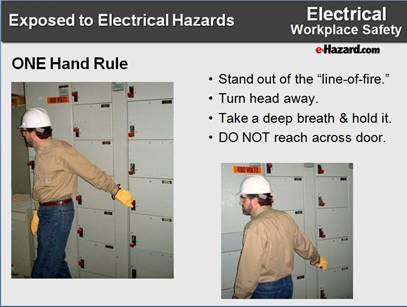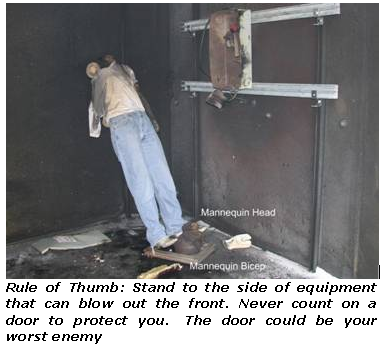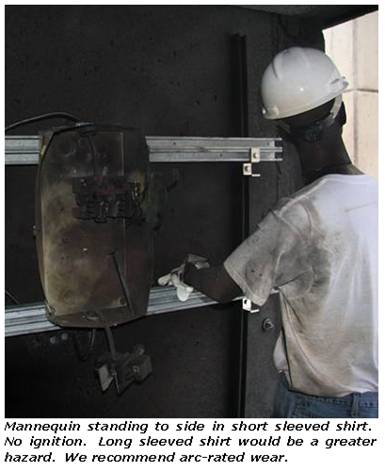Burn Up the Myth: Hinged Door Protection
Submitted by: Hugh Hoagland
 Question: A trainer told us that we should always stand on the hinged side of the door when operating equipment even if it means reaching across the equipment. Is this the best practice?
Question: A trainer told us that we should always stand on the hinged side of the door when operating equipment even if it means reaching across the equipment. Is this the best practice?
Answer: Probably not. Our training has included, since the beginning, a slide we have called the "One-Hand Rule". It is an adaptation of the "Left Hand Rule" that has been taught for years. Here is the slide we use.
I have been confronted that this is wrong by many trainers and consultants, so we decided to test the theory at Kinectrics lab last month during the IEEE-ESW Tour. We placed a 100 Amp disconnect on the vault wall and produced a 10kA and a 20kA phase-to-phase fault inside them. I purchased eight since I was confident they would fail. The disconnects were rated for 10-200kA depending on fuse type but most folks don't know this is for "bolted fault" not arc fault.
The arcing faults will almost always blow off the door especially if they go phase-to phase. Standing to the side is the most important thing. When the mannequin was standing in the position illustrated above, no t-shirts ignited and they would have been relatively unharmed in NFPA 70E compliant HRC 2 gear. When the mannequin stood in front it was disastrous see our NFPA 70E arc flash training video. When the mannequin stands to the hinged side with the arm across the door, the arm broke off and hit the concrete wall 6 feet away and bounced back several feet away. The biceps of the fiberglass arm can be seen at the mannequin's feet.


Note: I'm sure in some lower level arc flashes doors have protected folks (we often see this in switchgear) but when the door fails it is your worst enemy. Stand to the side and allow the door to protect the area. In our collective experience, doors do great UNLESS they come off. When they come off, it is almost always straight out just like the video test.
This testing was done by causing a phase-to-phase fault with a wire (difficult in real life but they do happen) and with >480V to help arc sustain. <480V arcs are difficult to sustain in real life BUT they will sustain when they go three phase, so to eliminate chance in the testing we used overvoltage of about 1000V to assure the arc would last for the whole test.
Hugh Hoagland
http://www.e-hazard.com/